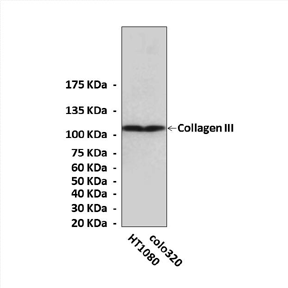Anti-Collagen Type III: Mouse Collagen Type III Antibody |
 |
BACKGROUND The collagens are a family of closely related but distinct extracellular matrix proteins. At least 19 proteins representing more than 30 gene products have now been defined as collagens, and at least another 10 proteins contain collagen-like domains. All collagen molecules consist of three polypeptide chains, called alpha chains, which are coiled around one another into a triple-helical conformation. In some collagen types all three alpha chains of the molecule are identical, while in others the molecule contains two or three different alpha chains. The most abundant collagens form extracellular fibrils and are hence known as fibril-forming collagens, while others form supramolecular aggregates of other kinds.1
Type III collagen is a member of the fibrillar collagen family and comprises three alpha1 (III) chains. Type III collagen is expressed in early embryos and throughout embryogenesis. In the adult, type III collagen is a major component of the extracellular matrix in a variety of internal organs and skin. Type III collagen is localized with the most abundant member of the family, type I collagen, in such tissues as blood vessels and skin. Mutations in the COL3A1 gene have been implicated as a cause of type IV Ehlers–Danlos syndrome, a disease leading to aortic rupture in early adult life.2
Type III collagen is a member of the fibrillar collagen family and comprises three alpha1 (III) chains. Type III collagen is expressed in early embryos and throughout embryogenesis. In the adult, type III collagen is a major component of the extracellular matrix in a variety of internal organs and skin. Type III collagen is localized with the most abundant member of the family, type I collagen, in such tissues as blood vessels and skin. Mutations in the COL3A1 gene have been implicated as a cause of type IV Ehlers–Danlos syndrome, a disease leading to aortic rupture in early adult life.2
REFERENCES
1. Knott, J. & Bailey, A.J.: Bone 22:181-7, 1998
2. Powell, J.T. et al: Eur. J. Vascu. Surg. 5:145-8, 1991
2. Powell, J.T. et al: Eur. J. Vascu. Surg. 5:145-8, 1991
Products are for research use only. They are not intended for human, animal, or diagnostic applications.
Параметры
Cat.No.: | CA11029 |
Antigen: | Short peptide from human type III collagen sequence. |
Isotype: | Mouse IgG |
Species & predicted species cross- reactivity ( ): | Human, Mouse, Rat |
Applications & Suggested starting dilutions:* | WB 1:1000 IP n/d IHC 1:50 - 1:200 ICC n/d FACS n/d |
Predicted Molecular Weight of protein: | 110 kDa |
Specificity/Sensitivity: | Detects endogenous levels of type III collagen proteins without cross-reactivity with other related proteins. |
Storage: | Store at -20°C, 4°C for frequent use. Avoid repeated freeze-thaw cycles. |
*Optimal working dilutions must be determined by end user.
Документы
Информация представлена исключительно в ознакомительных целях и ни при каких условиях не является публичной офертой








